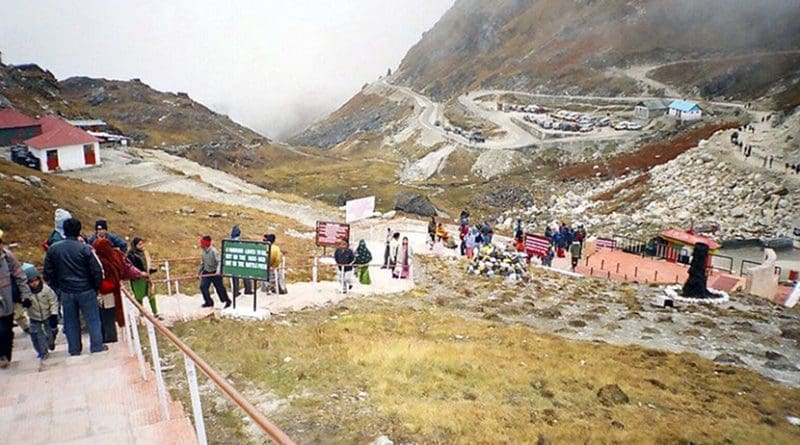A Pug, A Terrier And The Doklam Stand Off – Analysis
By IPCS
By Vice Admiral (retd) Vijay Shankar*
William Moorcroft, a British veterinary surgeon of the East India Company, set off in 1816 on an expedition to the Kailas region of Tibet to search for that breed of Central Asian horses that would revitalise the blood stock of the Company’s cavalry. His quest took him to a Tibetan official, where to his astonishment he was greeted not by his fabled strain of mounts but by two familiar breed of dogs – one a Pug and the other a Terrier, both alien to the land. So where had they come from? The answer, took a while to sink in: Tsar Alexander’s army had got here before the British.
A shadowy war was underway for control of the strategic passes, plateaus and wastelands of Tibet and Central Asia that led to India. However, Russian intent on conquest then, seemed inconceivable to the Raj. It was not till the middle of the 19th Century when the Khanates along the route fell, that the curtains lifted on the ‘Great Game’. As the frontiers of the two empires loomed, it exposed the ill-surveyed and poorly guarded borders of Northern India. It took the British Empire four decades after Moorcroft’s ‘close encounter’ to fully appreciate the significance of the ‘Pug and the Terrier’.
The Great Game ended after two revolutions and another half century. Yet its legacy of where the Northern frontiers of India lay remained confused, as the British used little else than artful cartography and more of imperial disdain to redraw empire. The modern Indian state has yet to reconcile this dangerous historical equivocation. Early political leadership in India had a cavalier and sometimes Arcadian perspective of history. The absence of unprejudiced attempts at defining geography has left indistinct borderlands to this day that suppurate with disturbing regularity. The region of the Doklam plateau in the tri-junction of India, China and Bhutan is one such region.
Doklam is situated roughly 15kms east of the Nathu La pass that separates India and China. On the western edge of the Doklam plateau is Doka La, which connects Sikkim with either Tibet (Chinese Government claim) or links Sikkim to western Bhutan. In June 2017, China attempted to extend a road southward across Yadong county, the wedge at the mouth of the Chumbi valley, leading to the thin edge. So, on 18 June 2017, Indian troops crossed into the territory to prevent construction of the road. China has criticised India for entering its “territory”. With Bhutan the dispute involves, a matter of 764sq kms of territory on the Doklam Plateau. The ‘Wedge’ has enormous strategic significance for China, Bhutan as well as India.
Recall in 1962, the real anxiety was that the thrust of China’s Army of Tibet would develop on a North-South axis from the Chumbi Valley to cut off the strategically vital Siliguri corridor (Chicken’s Neck). In 1965 again China in support of Pakistan, threatened to open this front. If China were to ever get hold of this territory, the Northeast would remain in a state of unremitting peril. The India-Bhutan Friendship Treaty of 2007, successor to the 1949 Treaty of ‘Perpetual Peace and Friendship’, pledges close ‘cooperation on issues relating to national interests and security’. It mirrors Bhutanese trepidation of a Tibet encore.
Central to the current stand-off is the building of logistical infrastructure across the disputed plateau that would provide a spring board to drive across the Chicken’s neck. India along with Bhutan has stepped into the disputed area to block advancement of the road. So what has urged Beijing to incite this incident? There are three impulsions which have a bearing on the impasse: first, India’s maritime manoeuvres (‘Malabar’) in the northern Indian Ocean with the US and Japan underscore resolve to achieve cooperative security and control against an aggressive and revisionist China; second, India’s strategic disinclination to come on board on One Belt One Road (OBOR) for reasons of it being “long on politics and spare on economics” has not gone down well with China. Besides the China-Pakistan Economic Corridor is offensive as it passes through the disputed Pakistan-Occupied Kashmir (POK); and last, the India-Bhutan security compact is abhorrent to China and needed to be put to test.
And what of an improbable escalation to a hot conflict? Clearly the Indian military is prepared. It is also clear that conflict will be waged on terms advantageous to India. In addition to operational manoeuvres undertaken to check China’s land forces, the superior deployable Indian Air Force will endeavour to assure a favourable situation in the skies to progress operations on the ground while the Indian Navy will strive to deny the northern Indian Ocean to the People’s Liberation Army Navy (PLAN) exertions as it exercises control over shipping in the busiest lanes of the world located in Arabian Sea and Bay of Bengal, targeting hulls bound for China. Obviously these missions are neither small in scope nor will they come without losses; an eventuality that both nations must be sensitive to will be to the detriment of their larger development goals.
And all this ado for the indifference to misplaced Pugs and Terriers.
*Vice Admiral (retd) Vijay Shankar
Former Commander-in-Chief, Strategic Forces Command of India

